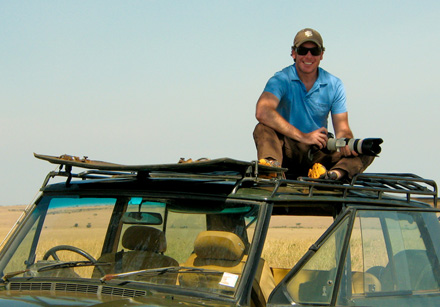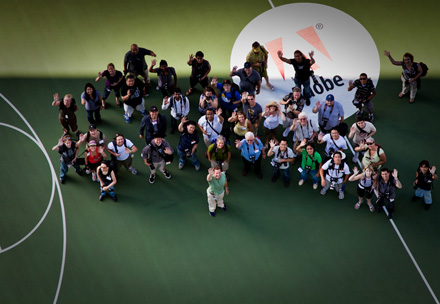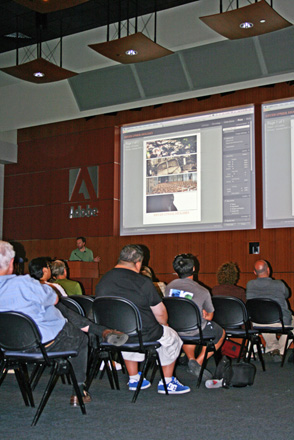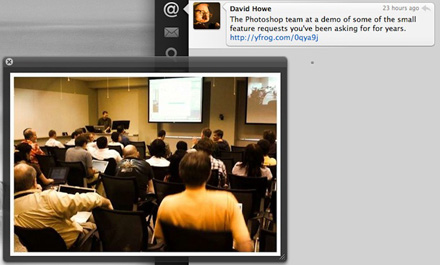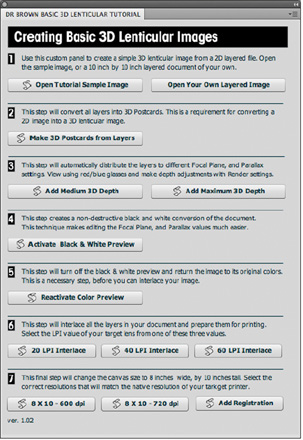Before anything else, I’d like to extend a big “thank you!” to Scott for having me back. I really enjoyed my last visit here and was very appreciative of all of your comments. Fresh from leading the Adobe Headquarters Photo Walk in San Jose, I’d also like to call out what Scott and everyone at the NAPP do; not just for education on a wide array of Adobe products, but their celebration for the passion of photography. My favorite part of my job is seeing what people do with our software and the excitement and creativity it brings to them; Saturday’s Photo Walk offered a really nice perspective on what that looks like early on, from behind-the-person-behind-the-lens. Here in San Jose, we enjoyed a full house; had a special guest participant, and I finished with Lightroom 2.0 and Photoshop CS4 demos from our own Park conference room – a great way to spend a Saturday. Thanks to Scott & friends for putting me in touch with some great people and talented shooters!
Although I’ve collaborated with Scott and the staff of the NAPP for many years, last year was my first trip out to NAPP headquarters. My experience there prompted what I’m going to share today.
Rewind to a few months before the CS4 launch: I’ve just spent two hours walking Scott and over a dozen NAPP staff through a long, thorough introduction of Photoshop CS4 (and Extended). We covered a lot of ground and focused on what I consider the release’s four (major) pillars: integration, performance, usability and “magic”. Although I felt that I came prepared, I should have known they’d be as ready for me as I was for them. No sooner did we wrap, following a very enthusiastic response to the release, with all of us very excited to communicate the news, I heard…”as long as we have you here”:
“so, what about___________?”
“did you fix ______________?”
“could you just make ______________?”
I’m no stranger to these; in all of my time here (10 years on July 29th!) I’ve heard two questions more than any others:
“could you change/fix/add_____________?”
and
“what’s coming next?”
The questions had a louder volume in Florida: this wasn’t just coming from the NAPP, but the voices of their 70,000+ members (our most passionate customers)! The next few hours were spent furiously typing away, capturing what became a very energetic, free form discussion about “the little things” (think “double click to rename layers in the layers panel” – circa PS7; think “stroke color changed to black” – circa CS4). It isn’t that we’re oblivious to these minor details. In-fact I think we’re doing better than ever there; see this great post from my friend and colleague John Nack for an example of what CS4 brought in terms of “the little things”:
http://blogs.adobe.com/jnack/2008/09/cs4_sweating_the_details.html
…but Photoshop users expect a lot, and they represent a wide array of fields; these days we all think of photography, and I’m thrilled that my first love is enjoying such a dramatic 2nd coming; but Photoshop and Photoshop Extended serve designers, web authors, retouchers, illustrators, 3D artists, architects, engineers, science and medical professionals and dozens and dozens more. It turns out that “the little things” mean a lot of things to a lot of people. Luckily, I had a very broad list, compliments of my visit.
I spent the long flight back cleaning up what I’d brought back from Florida. There were some tall orders, but most things seemed (at least theoretically) attainable. I knew we had a BIG, busy release already underway, but I also knew that we had wanted to borrow a play out of the After Effects development book and institute JDI or “Just Do It” days – a week’s worth of coding where engineers and testers put their pencils down and address minor things that (all too often) have a way of slipping through the cracks.
I polished the list, added a number of UI wireframes (only Scott and Matt K. would send a feature request with their very own UI comps!) and started sharing it internally. It turns out that just about everyone had a list of things they would love to do or see done. Between Julieanne Kost and John Nack alone, the list almost doubled. Then I started asking more broadly – Quality Engineering, Customer Support, User Research, Sales, User Groups (fellow Product Manager Zorana Gee runs the SF Photoshop User Group and I handle San Jose; that right there was good for a few hundred voices), forums, etc. Pretty soon people I hadn’t even solicited started providing me with items. An interesting pattern started to emerge: as the responses grew, the list stabilized and soon we saw validation for certain requests grow stronger and louder.
It was obvious early on that there were really two lists, “JDI” features were the very minor requests and tweaks (things that could be started AND finished by one engineer and one tester in a week) and TCR or “Top Customer Requests” were much larger (a very important distinction – these that would need to be handled full-time by a separate group, like other, larger features). When it came to distilling a huge pile of data, John proved invaluable by soliciting both requests and validations in a blog post/survey that undoubtedly cost him a lot of sleep, but ultimately yielded ~1,000 opinions and ~500 comments/requests!
http://blogs.adobe.com/jnack/2009/06/feedback_please_jdi.html
As we balanced a “final” list of 50+ JDI items to align with priority, attainability and greater themes of our larger features (I can’t say more, but know that there is much greater work underway…as always) we were ready for our first JDI week. The Photoshop Team had never done this before and we weren’t certain what to expect. My colleague Steve Snyder in Program Management agreed that 15 items completed in one week would be a huge success. At the close of the week, we were amazed at what the team had pulled together – 25 completed, tested features! Today I’d like to give you an early preview of just three of those:
Adjustment Panel changes
The Adjustment Panel dramatically improves the speed and discoverability of a layer-based workflow in CS4. It actually goes far beyond just that; but we know that like any 1.0 implementation, we have opportunities to polish the details. Citing feedback from John’s blog, we’ve been able to add a shortcut (controlled by preference) to the panel and one for the powerful on-image control, as well.
Save to unsupported bit depth
Whether users are scanning at high bit depth, moving 16-bit files from Lightroom/Adobe Camera Raw or just enjoying the extensive support for 16-bit editing found in Photoshop, we acknowledge that needing to down-sample files to 8-bit before saving as a JPEG can be a significant hindrance to workflow performance and can act as a seemingly unnecessary interruption (not to mention it can be confusing when JPEG does not appear as a save option). To this point, we will offer the ability to save these (and convert) easily and seamlessly.
Control gesture support (from the application)
Scott, this is for you ;-)
On MacBook Air and recent MacBook Pro systems, Adobe Photoshop CS4 can use a multitouch gesture to enable rotation of the document canvas. Some customers find that the canvas gets rotated accidentally through inadvertent use of the gesture on the trackpad.
Not too long ago we released an update to Photoshop CS4, at the same time we posted a plug-in that could disable the trackpad behavior – that can be found here:
http://www.adobe.com/support/downloads/detail.jsp?ftpID=4337
We realized that we needed to offer that as a user-by-user preference in the application though, and so that’s what we’ve implemented here. In the future there will be no need to find, install/uninstall this preference – instead you’ll be able to treat it like any other temporary change, from within the application.
Again, those are all in the future and are just a few examples of what we’ve been up to…but I thought you’d all enjoy knowing that we’re listening to what you’re saying and responding with more focus than ever before.
You might be asking yourself, “if you can do those so quickly…can you also________; would you___________?”. Again, these are minor – and balanced with the schedule I’m thrilled we’ll be providing them, but we need to consider them alongside much larger projects. However, I will say that the success of these opened the door for more of this sort of thing (we’re planning to stage one more JDI week)…and to that point, I’m proud to announce that we’ll soon have a mechanism that sends your requests directly to the team! So, “yes, we can”…”yes, we did” and “yes, we will” to so many of these (minor) requests and questions. I’ll be following-up with this post and Scott to share our mechanism for soliciting your feedback in the near future. In the meantime, let this be the first place and time (of many to come) that I publicly thank the Photoshop Team for their exhaustive support of our users – I am very proud to be sharing this news with all of you.
So that’s all a ways in the future; let’s come back to today. CS4 has been out less than a year and there’s both a ton that we shipped with it and that we’ve added since. I know I mentioned a number of things the last time I was here and briefly on Photoshop User TV, but I wanted to call out a few really nice additions to Lightroom 2.0 and Photoshop CS4.
Pixel Bender
I often have people ask me, “are there any new filters in CS4?”. Yes, HUNDREDS. Pixel Bender, available as both a toolkit for development and an exchange of downloadable, user-generated filters is one of many things that compliment CS4 and enjoys GPU-acceleration (try toggling the GPU support off and on to see what a huge stride we’ve made with support of these computers within computers). Here’s a link to what currently constitutes 23 pages of filters!
http://www.adobe.com/cfusion/exchange/index.cfm?event=productHome&exc=26&loc=en_us
Configurator
Photoshop CS4 has the ability to host Flash Panels. Flash Panels mean many different things to various suite applications and our developers, but what do they mean to everyday people like us? Well, thanks to Configurator, anyone can now “lego” together custom UI. With walk-up simplicity you can build panels of your favorite tools, actions, scripts, commands, even video!– if you can do it in Photoshop, you can launch it from a panel, thanks to Configurator. The free download for anyone using CS4 is here:
http://labs.adobe.com/technologies/configurator/
For much more on what’s possible, look no further than John’s blog:
http://blogs.adobe.com/jnack/2008/10/introducing_ado_1.html
DNG Profile Editor
Anyone who has heard me speak has likely heard me sing praise to the DNG format. The latest magic in this smaller (yes, smaller than your proprietary raw file) format is the ability to create your own very specific profiles with a new, free utility. This can mean many things: consistency amongst different camera bodies, makes and manufacturers; the ability to build custom infrared or B&W profiles (far beyond what can be done in a raw editor) a powerful way to assure color accuracy in mixed light (product photographers, this is made for you) and much more. The tutorial looks rather daunting, but it isn’t too tough, I promise. A nice summary here:
http://blogs.adobe.com/jnack/2008/08/the_dng_profile_editor.html
and the link to the lab download here:
http://labs.adobe.com/wiki/index.php/DNG_Profiles
Lastly, we’ve released several updates to both Adobe Camera Raw and Lightroom; providing both minor fixes and extensive new support. Our professional digital imaging applications now host well in excess of 200 proprietary raw formats.
There’s always much, much more…but for now, thank you for reading and please keep watch for a way to communicate your requests directly to us. You know what? If you just can’t wait, go ahead and send them to me directly at bhughes@adobe.com – I can’t promise a response, but I will make sure the team takes a good look.
-Bryan O’Neil Hughes



